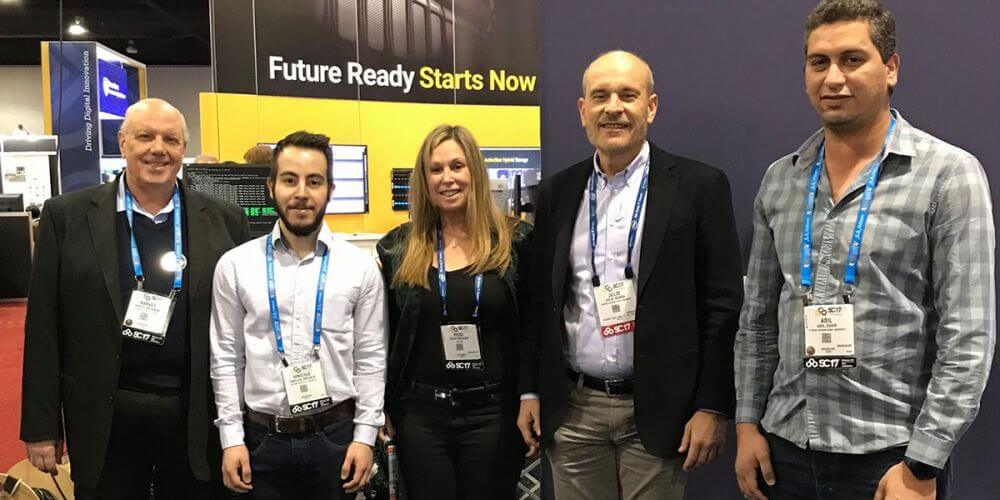
ISI’s Heidi Morgan pictured at the SuperComputing17 conference with (left to right) Harvey B. Newman, Marvin L. Goldberg Professor of Physics, Division of Physics, Mathematics and Astronomy, Caltech; Vinicius Arcanjo, AmLight Sr. Network Engineer (RNP); Julio Ibarra, Assistant Vice President of Technology Augmented Research, Center for Internet Augmented Research and Assessment (CIARA), Florida International University (FIU); Adil Zahir, Network Engineer, CIARA, FIU.
ISI senior computer scientist Heidi Morgan is spearheading the development of reliable, leading- edge infrastructure for research and education between the U.S. and Latin American countries.
Morgan, who joined ISI from Florida International University in April 2016, is co-principal investigator of a collaborative project called America’s Lightpaths Express and Protect (AmLight Exp).
The project is part of the AmLight Consortium—a group of not-for-profit universities and research and education networks—developed in response to the growing network requirements of U.S.-Latin America collaborative science research activities.
“This cyberinfrastructure is critical to further educational collaboration and understanding between North and South America,” says Morgan, whose work at ISI focuses on supporting US and global scientific collaborations through safe and robust cyberinfrastructure.
“The network robustness enables big data science discovery particularly in the areas of high-energy physics and astronomy.”
In a major breakthrough for networking, the technology was recently leveraged at the SuperComputing17 conference, hosted in Denver, Colorado, Nov. 12-17, 2017, to transport large data-sets on 100 Gbps links between São Paulo, Miami, and Denver.
The system was put to the test on Nov. 16, when several conference demonstrations were encouraged to generate as much network traffic as possible to fill-up SC17 links. A steady 370 Gbps total aggregated traffic was successfully transported, showcasing the capabilities of the system.
In a news release, Eduardo Grizendi, director of engineering and operations with Brazil’s National Education and Research Network (RNP), said: “Exercising and stressing intensive data transfers on multiple 100 Gbps WAN links between the United States and South America, especially, between Sao Paulo, Miami and Denver, give us confidence to support a service of intensive data transfers for our academic community, regionally or on globally distributed science programs.”
Scientific research and educational activities carried out between the U.S. and Latin American countries have been evolving in recent years, benefiting from the shared investments made by the U.S., Brazil and other countries in Latin America.
In fact, total bandwidth provided by AmLight ExP between the U.S. and South America is expected to grow to more than 680 Gigabits per second in aggregate capacity between 2015 and 2020.
The ultimate goal, says Morgan, is to increase speed of discovery in the U.S. and across the Western Hemisphere, promote collaboration across diverse communities, and drive innovation to benefit society.
“The AmLight consortium is committed to serving the needs graduate and undergraduate education through models that bring together students and the networking community with scientists from all domains,” says Morgan.
“AmLight ExP acts as a catalyst for new communities of researchers and learners with a bridge linking Latin Americans of the Western Hemisphere, benefiting U.S Hispanic students, teachers and researchers.”
The project is supported by the National Science Foundation, with significant investments from the Academic Network of São Paulo (ANSP), and Rede Nacional de Ensino e Pesquisa (RNP) and the Association of Universities for Research in Astronomy (AURA).













